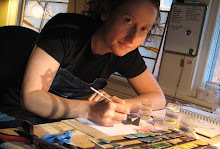
I've said it before, but I do love working on many, many pieces at once. I've got tons of ideas, and it's just too hard to choose which ones to make next, so I usually just make everything. It really brings each step into perfect focus if you get to spend days doing one simple step. Warren read somewhere that to become the master of a task, you should do it for 10,000 hours. I must be getting pretty close by now!
For this new batch, I spent two solid days just cutting out all the shapes. I'm trying something new with this batch. For the earrings, I've switched to 22 gauge fine silver. I'm making some larger earrings this go-around, and I was concerned that they might be uncomfortably heavy for the wearer. That, and I've had a couple of 22 gauge silver sheets hanging around my studio for ages, and I need to use them for something!
 The bases need to be fused, as opposed to soldered, because the enamels hate solder. I set up a little tripod and heat the two pieces from beneath. I've tried doing it from the top, but the smaller cutout tends to heat up way too fast and will melt long before the larger sheet underneath comes up to temperature. It's a very intuitive process- I keep my torch moving and try to heat everything up evenly. Just as things start glowing a dull orange, I'll look for the barest shimmer of melting silver. It happens lightning fast. At that moment, you need to draw the shimmer across the whole surface and then pull away! One moment to long, and the silver will pool into a sad little puddle.
The bases need to be fused, as opposed to soldered, because the enamels hate solder. I set up a little tripod and heat the two pieces from beneath. I've tried doing it from the top, but the smaller cutout tends to heat up way too fast and will melt long before the larger sheet underneath comes up to temperature. It's a very intuitive process- I keep my torch moving and try to heat everything up evenly. Just as things start glowing a dull orange, I'll look for the barest shimmer of melting silver. It happens lightning fast. At that moment, you need to draw the shimmer across the whole surface and then pull away! One moment to long, and the silver will pool into a sad little puddle.The 22 gauge was tricky, since it was thinner that I'm used to. I did finally get the hang of it, but I have to say that 20 gauge is way more satisfying. Here are some fused pieces:

Not sure you can tell, but here's a pic of what I'm looking for in a perfectly fused piece. Do you see that perfect line of silver where the two pieces meet? The edges are still crisp, and the surface of the silver has taken on a strange and lovely crystalline appearance. And the two pieces have become one solid unit:
 Besides the 22 gauge silver, I had one other challenge with this set of designs. My dragon necklace is the largest single piece of fused silver that I've ever done. I wasn't sure it was even going to be possible to fuse such a large piece. I approached it a little differently than I would a smaller piece. Instead of trying to do it all in one go, I fused it in stages, and hammered it flat in between. It took seven torchings, and each one was agonizing, but it all finally came together. The final necklace will consist of two pieces. The second wing will be connected with loops to the main body. You'll just have to wait and see:
Besides the 22 gauge silver, I had one other challenge with this set of designs. My dragon necklace is the largest single piece of fused silver that I've ever done. I wasn't sure it was even going to be possible to fuse such a large piece. I approached it a little differently than I would a smaller piece. Instead of trying to do it all in one go, I fused it in stages, and hammered it flat in between. It took seven torchings, and each one was agonizing, but it all finally came together. The final necklace will consist of two pieces. The second wing will be connected with loops to the main body. You'll just have to wait and see: Lastly, here's a pic of my friend Betty McKim, who is getting ready for all her upcoming shows, and who is a phenomenal jeweler! I love working at Pullen and chit-chatting with Betty!
Lastly, here's a pic of my friend Betty McKim, who is getting ready for all her upcoming shows, and who is a phenomenal jeweler! I love working at Pullen and chit-chatting with Betty!






























